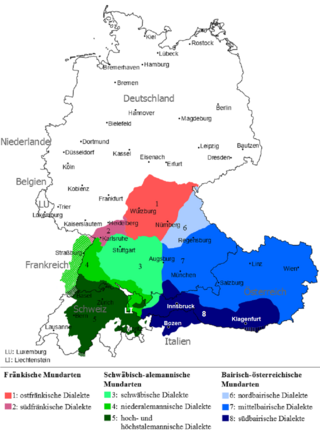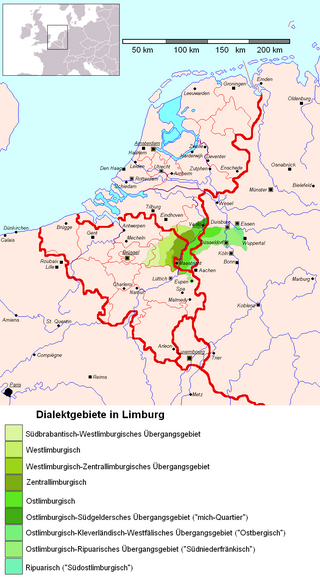Related Research Articles

Old Prussian, also known as Baltic Prussian is an extinct West Baltic language belonging to the Baltic branch of the Indo-European languages, which was once spoken by the Old Prussians, the Baltic peoples of the Prussian region. The language is called Old Prussian to avoid confusion with the German dialects of Low Prussian and High Prussian and with the adjective Prussian as it relates to the later German state. Old Prussian began to be written down in the Latin alphabet in about the 13th century, and a small amount of literature in the language survives.
Westphalian or Westfalish is one of the major dialect groups of Low German. Its most salient feature is its diphthongization. For example, speakers say iäten instead of etten or äten for "to eat".
Silesian, Silesian German or Lower Silesian is a nearly extinct German dialect spoken in Silesia. It is part of the East Central German language area with some West Slavic and Lechitic influences. Silesian German emerged as the result of Late Medieval German migration to Silesia, which had been inhabited by Lechitic or West Slavic peoples in the Early Middle Ages.

East Low German is a group of Low German dialects spoken in north-eastern Germany as well as by minorities in northern Poland. Together with West Low German dialects, it forms a dialect continuum of the Low German language. Before 1945, the dialect was spoken along the entire then-German-settled Baltic Coast from Mecklenburg, through Pomerania, West Prussia into certain villages of the East Prussian Klaipėda Region.

Ripuarian is a German dialect group, part of the West Central German language group. Together with the Moselle Franconian which includes the Luxembourgish language, Ripuarian belongs to the larger Central Franconian dialect family and also to the linguistic continuum with the Low Franconian languages.
Low Prussian, sometimes known simply as Prussian (Preußisch), is a moribund dialect of East Low German that developed in East Prussia. Low Prussian was spoken in East and West Prussia and Danzig up to 1945. In Danzig it formed the basis of the particular city dialect of Danzig German. It developed on a Baltic substrate through the influx of Dutch- and Low German-speaking immigrants. It supplanted Old Prussian, which became extinct in the early 18th century.

East Franconian or Mainfränkisch, usually referred to as Franconian in German, is a dialect spoken in Franconia, the northern part of the federal state of Bavaria and other areas in Germany around Nuremberg, Bamberg, Coburg, Würzburg, Hof, Bayreuth, Meiningen, Bad Mergentheim, and Crailsheim. The major subgroups are Unterostfränkisch, Oberostfränkisch and Südostfränkisch.
Eastern Low Prussian is a subdialect of Low Prussian that was spoken around Angerburg, Insterburg, Memelland, and Tilsit in the eastern territories of East Prussia in the former eastern territories of Germany. Many speakers of this subdialect were Prussian Lithuanians.
The Kürzungsgebietsmundart is a subdialect of Low Prussian, part of Low German, spoken in today's Poland. In 1918, it was spoken in East Prussia and West Prussia in their respective then borders. The Kürzungsgebietsmundart was spoken around Braunsberg and Frauenburg and had a border to Natangian, Westkäslausch, Mundart der Elbinger Höhe and Oberländisch. There was influence of Salzburgers. The Western border to Elbing Upland was a border of denominations. Part of its Southern border was undetermined by political or religious borders. Long e before p, t and k is shortened to short i, long o before t and k is shortened to u. In the western part, also long u before k was shortend to short u. Between Plasswich and Borchertsdorf, its only border to High Prussian ran.
High Prussian is a group of East Central German dialects in former East Prussia, in present-day Warmian-Masurian Voivodeship (Poland) and Kaliningrad Oblast (Russia). High Prussian developed in the 13th–15th centuries, brought in by German settlers mainly from Silesia and Thuringia, and was influenced by the Baltic Old Prussian language.

Bergish is a collective name for a group of West Germanic dialects spoken in the Bergisches Land region east of the Rhine in western Germany.
Strand Frisian was a dialect of the North Frisian language which was originally spoken on Strand island, Duchy of Schleswig. Strand was destroyed in the Burchardi flood of 1634 with its remnants forming the islands Pellworm and Nordstrand which are now part of Germany. Strand Frisian is counted among the mainland group of North Frisian dialects.
Arthur Hübner was a German philologist. He specialized in research of German literature from the Middle Ages.
Ostkäslausch is a Low Prussian dialect of Low German spoken in an area of Poland, that used to be part of Germany.
Elbingian was a subdialect of Low Prussian spoken in East Prussia and West Prussia in the region of the Elbingian upland, north of Elbing. It had a border with Oberländisch, Mundart des Kürzungsgebiets and Nehrungisch. It used to end shortly East of Elbing river.
Samlandic was a Low Prussian dialect of Low German. It was divided into Ostsamländisch and Westsamländisch. Both were from East Prussia.
Westkäslausch was a Low Prussian dialect spoken in East Prussia, Germany . It has features of Eastphalian, Westphalian and East Pomeranian dialect.
Nehrungisch is a subdialect of Low Prussian, belonging to the Low German language variety. It was spoken in East Prussia and West Prussia, in the region around the Vistula Spit near Danzig. The easternmost locality where this variety was spoken was Narmeln, and it was spoken from Narmeln to Krakau (Krakowiec). Its Eastern border was to Mundart der Elbinger Höhe,a Low Prussian variety. The dialect survives in Chortitza- Plautdietsch, a dialect of Plautdietsch brought to Ukraine by migrants from the Vistula region. The distinguishing Chortitza features were present in the Northeast of the Vistula delta.
Werdersch is a subdialect of Low Prussian, which itself is a subdialect of Low German. This dialect is spoken in Poland and was spoken in the former province of West Prussia. Werdersch is closely related to Nehrungisch and Plautdietsch.
The Vistulan dialect was a dialect of Low Prussian, which belongs to Low German. The dialect was spoken in West Prussia around Zarnowitzer See, Danzig and Graudenz. It had a border to Mundart der Weichselwerder. It is related to Nehrungisch.
References
- ↑ Walther Ziesemer, Die ostpreußischen Mundarten. Proben und Darstellung, Ferdinand Hirt, Breslau 1924, p. 125 and 129 in the section 6. Das Niederpreußische
- ↑ Walther Ziesemer, Die ostpreußischen Mundarten, Ferdinand Hirt, Breslau, 1924, p. 137 (map Die ostpreußischen Mundarten)
- ↑ Bense, Gertrud; Kozianka, Maria; Meinhold, Gottfried, eds. (1995). Deutsch-Litauische Kulturbeziehungen (PDF). Universitätsverlag Druckhaus Mayer Jena. ISBN 3925978380.
- ↑ Walther Mitzka. Kleine Schriften. Walter de Gruyter & Co., 1968, p. 298
- ↑ Walther Ziesemer, Die ostpreußischen Mundarten, Ferdinand Hirt, Breslau, 1924, p. 129
- ↑ Walther Ziesemer, Die ostpreußischen Mundarten, Ferdinand Hirt, Breslau, 1924, p. 132
- ↑ Walther Mitzka. Kleine Schriften zur Sprachgeschichte und Sprachgeographie. Walter de Gruyter, Berlin 1968, p. 324